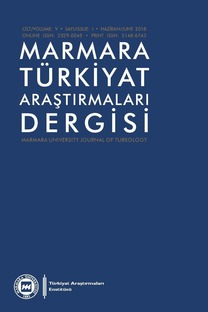Bizans ve Birinci Haçlı Seferi: Üç Yaklaşım
Birinci Haçlı Seferi’nin tarih yazımında tekrar eden tema, Bizans imparatorunun Papa Urbanus’tan Türklere
karşı küçük bir birlik göndermesini istemesi fakat bunun yerine üzerinde hiçbir kontrolünün olmadığı büyük
orduları elde etmesi üzerinedir. Dolayısıyla Haçlı seferi beklenmedik bir olaydır ve oluşumunda imparatorun
hiçbir rolü yoktur. Daha önce bu konu üzerine yapılmış çalışmalar bu tez üzerine idi fakat daha sonra farklı
görüşler ortaya çıkmaya başladı. İkinci teori ise bunun dış politikada yeni bir çıkış olduğu üzerinedir. İmparator
aslında Birinci Haçlı Seferi’nin oluşmasında oldukça etkilidir ve Haçlı Seferi’nin idealleri ile hedefinin
şekillendirilmesinde öncü rol oynamıştır. Üçüncü görüş ise daha ılımlıdır. Buna göre imparator kesinlikle işin
içinde olmakla birlikte bu ilk defa görülen bir durum değildir. Bu durum sadece krize karşı alışılagelmiş bir
tepkinin genişletilmesi idi. Bu tepki dış müttefikler arama, onları finansal olarak teşvik etme ve anlaşmaya
manevî bir öge katmayı içermektedir. Bizans imparatoru ile Haçlılar arasında yanlış anlaşılmaya neden olan
konu bu son taktiğin uygulanmasıdır.
Anahtar Kelimeler:
Haçlılar, Bizans tarihi, İmparatorluk politikaları, Komnenoslar
Byzantium and the First Crusade: Three Avenues of Approach
A recurring theme in the historiography of the First Crusade is that of the Byzantine emperor asking Pope
Urban to send a small contingent against the Turks and receiving instead vast armies over which he had no
control. The crusade was thus completely unexpected and the emperor played no part in its genesis. Recent
work has challenged that thesis and further approaches have emerged. A second theory argues that this was a
novel departure in foreign policy. The emperor was in fact deeply involved in the origins of the First Crusade
and played a leading role in shaping its ideals and goals. The third approach is more modest in scope: it argues
that he was certainly involved but this was no unprecedented innovation, simply the extension of a tried and
tested response to crisis. This response involved seeking outside allies, providing them with a financial incentive
and even bringing a spiritual element into the agreement. It was the use of the last of these standard tactics that
was to lead to misunderstandings between the Byzantine emperor and the crusaders.
Keywords:
Crusades, Byzantine history, Imperial politics, Komnenoi,
___
- Albert of Aachen, Historia Ierosolimitana: History of the Journey to Jerusalem, çev. S. Edgington, Oxford 2007.
- Anna Komnene, Alexias, ed. D.R. Reinsch, Cologne 1996. İngilizce tercüme: E. R. A. Sewter and P. Frankopan, The Alexiad, London 2009.
- Benzo of Alba, Ad Henricum Imperatorem Libri VII, ed. K. Pertz (Monumenta Germaniae Historica Scriptores 11), Hannover 1854, 591-681.
- Bernold of St Blaise, Chronicon (Monumenta Germaniae Historica Scriptores 5), Hannover 1844, 385-467.
- Chronica Monasterii Casinensis (Monumenta Germaniae Historica Scriptores 34), ed. H. Hoffmann, Hanover 1980.
- Constantine VII Porphyrogenitos, De Administrando Imperio, ed. G. Moravcsik, çev. R. J. H. Jenkins (CFHB 1), Washington DC 1967.
- Ekkehard of Aura, Chronicon Universale (Monumenta Germaniae Historica Scriptores 6), Hannover 1844, 33- 245.
- Fulcher of Chartres, Historia Hierosolymitana (1095-1127), ed. H. Hagenmeyer, Heidelberg 1913. İngilizce tercüme: H. S. Fink – F. R. Ryan, History of the Expedition to Jerusalem, 1095-1127, New York 1969.
- Gesta Francorum. The Deeds of the Franks and the other Pilgrims to Jerusalem, ed. R. Hill, Oxford 1962.
- Hagenmeyer, H., Epistulae et Chartae ad Historiam Primi Belli Sacri Spectantes: die Kreuzzugsbriefe aus den Jahre 1088-1100, Innsbruck 1901.
- Leo the Deacon, Historiae Libri Decem, ed. C. B. Hase (CSHB), Bonn 1828. İngilizce tercüme: A. M. Talbot – D. Sullivan, The History of Leo the Deacon: Byzantine Military Expansion in the Tenth Century, Washington DC 2005.
- Liudprand of Cremona, Opera Omnia (Corpus Christianorum Continuatio Medievalis 156), ed. P. Chiesa, Turnhout 1998. İngilizce tercüme: P. Squatriti, The Complete Works of Liudprand of Cremona, Washington DC 2007.
- Nicholas I Mystikos, Letters, ed. ve çev. R. J. H. Jenkins – L. G. Westerink (CFHB 15), Washington DC 1973. Ralph of Caen, Gesta Tancredi, çev. B. S. Bachrach – D. S. Bachrach, Aldershot 2005.
- Raymond of Aguilers, Le “Liber” de Raymond d’Aguilers, ed. J. H. Hill – L. L. Hill, Paris 1969; İngilizce tercüme: Raymond of Aguilers, Historia Francorum qui Ceperunt Iherusalem, trans. J. H. Hill – L. L. Hill, Philadelphia 1968.
- Robert the Monk, Robert the Monk’s History of the First Crusade, çev. C. Sweetenham, Farnham – Burlington (VT) 2005.
- Rodulfus Glaber, Historiarum Libri Quinque, ed. ve çev. J. France, Oxford 1989.
- Theodore Skoutariotes, Synopsis Chronike, in C. N. Sathas (ed.), Μεσαιωνικὴ Βιβλιοθήκη, Athens – Venice – Paris 1872-94, vol. 7, 1-556.
- Skylitzes, John, Synopsis Historiarum, ed. J. Thurn (CFHB 5), Berlin ve New York 1973; İngilizce tercüme: J. Wortley, A Synopsis of Byzantine History, 811-1057, Cambridge 2010.
- William of Apulia, Le Geste de Robert Guiscard, çev. M. Mathieu, Palermo 1961.
- Yahya of Antioch, Cronache dell’Egitto fatimide e dell’impero bizantino (937-1033), çev. B. Pirone, Milan 1997.
- Zonaras, John, Epitome Historiarum, ed. L. Dindorf, Leipzig 1868-75.
- ISSN: 2148-6743
- Yayın Aralığı: Yılda 2 Sayı
- Başlangıç: 2014
- Yayıncı: Marmara Üniversitesi
Sayıdaki Diğer Makaleler
Selçuklu Meliki Davud’un Saltanat Mücadelesi
Abdülhak Hâmid’in Himayesinde Çıkan Bir Dergi: Asrî Türkiye Mecmûası
Kira Sözleşmelerinde Kullanılan Hukuk Benzeri Dilin Betimlemeli Çözümlenmesi
ABDÜLHAK HÂMID’IN HIMAYESINDE ÇIKAN BIR DERGI: ASRÎ TÜRKIYE MECMÛASI
Semavi Eyice ile Rumeli ve Türk Trakyası Üzerine Bir Söyleşi
Türkiye Türkçesindeki Farsça Kelimelerde Anlam Değişmeleri
Okan Celal GÜNGÖR, Esin Eren SOYSAL
